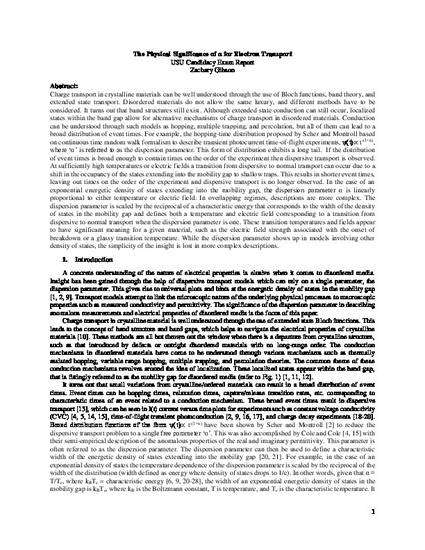
Unpublished Paper
The Physical Significance of α for Electron Transport
USU Physics PhD Candidacy Exam
(2019)
Abstract
Charge transport in crystalline materials can be well understood through the use of Bloch functions, band theory, and extended state transport. Disordered materials do not allow the same luxury, and different methods have to be considered. It turns out that band structures still exist. Although extended state conduction can still occur, localized states within the band gap allow for alternative mechanisms of charge transport in disordered materials. Conduction can be understood through such models as hopping, multiple trapping, and percolation, but all of them can lead to a broad distribution of event times. For example, the hopping-time distribution proposed by Scher and Montroll based on continuous time random walk formalism to describe transient photocurrent time-of-flight experiments, ψ(t)∝ t-(1+α), where ‘α’ is referred to as the dispersion parameter. This form of distribution exhibits a long tail. If the distribution of event times is broad enough to contain times on the order of the experiment then dispersive transport is observed. At sufficiently high temperatures or electric fields a transition from dispersive to normal transport can occur due to a shift in the occupancy of the states extending into the mobility gap to shallow traps. This results in shorter event times, leaving out times on the order of the experiment and dispersive transport is no longer observed. In the case of an exponential energetic density of states extending into the mobility gap, the dispersion parameter α is linearly proportional to either temperature or electric field. In overlapping regimes, descriptions are more complex. The dispersion parameter is scaled by the reciprocal of a characteristic energy that corresponds to the width of the density of states in the mobility gap and defines both a temperature and electric field corresponding to a transition from dispersive to normal transport when the dispersion parameter is one. These transition temperatures and fields appear to have significant meaning for a given material, such as the electric field strength associated with the onset of breakdown or a glassy transition temperature. While the dispersion parameter shows up in models involving other density of states, the simplicity of the insight is lost in more complex descriptions.
Disciplines
Publication Date
Fall September 19, 2019
Citation Information
Zachary Gibson. "The Physical Significance of α for Electron Transport" USU Physics PhD Candidacy Exam (2019) Available at: http://works.bepress.com/zachary-gibson/38/
